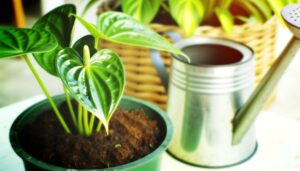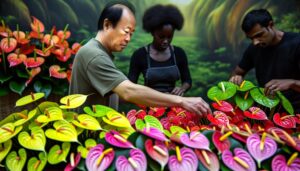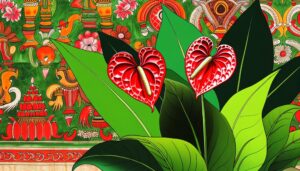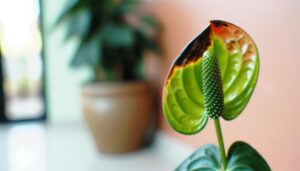Anthurium Meaning in Tagalog?
In Tagalog culture, Anthuriums symbolize deep affection, lasting love, and prosperity. Originating from Central and South American rainforests, these heart-shaped flowers are prized for their resilience and vibrant colors.
In the Philippines, Anthuriums represent hospitality and wealth, making them popular in both home decor and courtship rituals. They've traditional healing uses, such as treating skin ailments and respiratory issues.
Modern interpretations continue to associate them with prosperity and warm welcomes. Anthuriums are ideal for various occasions and are easy to care for.
There's a rich cultural and symbolic background that underscores their popularity in Filipino homes. Learn more about their intriguing roles and meanings.
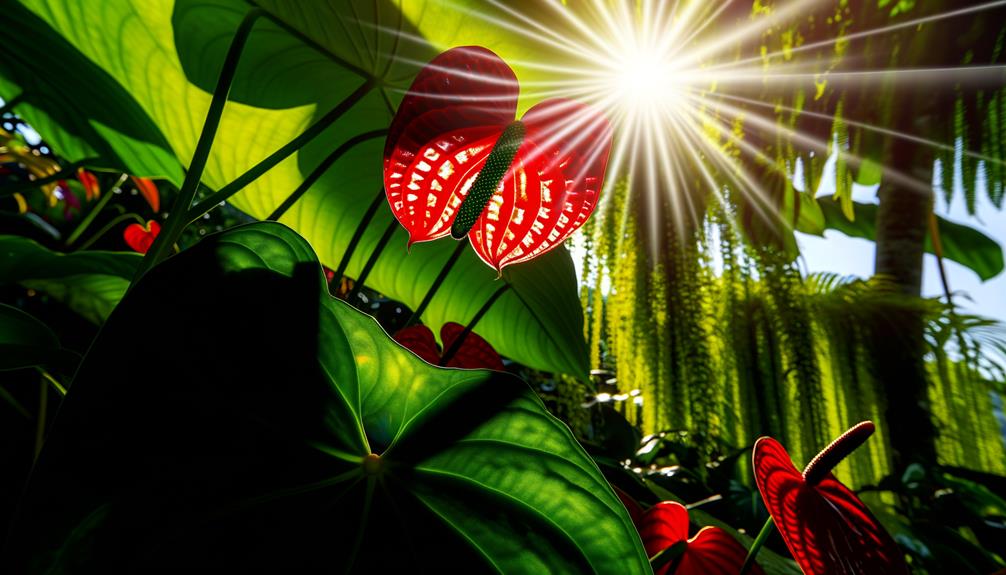
Key Takeaways
- Anthuriums symbolize deep affection and lasting love in Filipino culture.
- They represent hospitality, wealth, and enduring love.
- Anthuriums are used in courtship rituals and anniversaries.
- The flowers are believed to attract wealth and good fortune.
- They are a popular choice for home decor and public spaces due to their symbolism.
Origin and History
With roots tracing back to the tropical rainforests of Central and South America, Anthuriums have a rich history in botanical studies and horticulture.
You'll find that these plants were first categorized in the late 19th century by European botanists exploring these lush environments. These explorers were captivated by the unique structure of the Anthurium's spathes and spadices. The vibrant, waxy appearance of the flowers made them highly desirable for ornamental use.
Over time, growers have developed numerous hybrids to enhance color variety and resilience. Today, Anthuriums are cultivated worldwide, especially in humid, warm climates that mimic their native habitat.
Understanding this background helps you appreciate the plant's journey from rainforest obscurity to global horticultural prominence.
Symbolism in Filipino Culture
You'll find that anthuriums hold significant meaning in Filipino culture, particularly in traditional flower symbolism. They often represent love and relationships, reflecting deep emotional connections.
Today, their cultural significance persists, influencing modern interpretations and practices.
Traditional Flower Symbolism
Traditional flower symbolism in Filipino culture intertwines botanical elements with deep-seated beliefs, where each bloom carries specific meanings and emotional resonance. You'll find that flowers aren't just aesthetically pleasing; they convey messages and sentiments grounded in tradition. For instance, sampaguita, the national flower, symbolizes purity and humility. The ylang-ylang, known for its fragrant oil, represents love and seduction.
Here's a quick reference table for some traditional flowers and their meanings:
| Flower | Symbolism |
|---|---|
| Sampaguita | Purity, Humility |
| Ylang-Ylang | Love, Seduction |
| Gumamela | Sincerity, Devotion |
Understanding these floral symbols can enrich your appreciation of Filipino culture, offering insights into how flowers are more than mere decorative elements.
Love and Relationships
In Filipino culture, the symbolism of flowers extends deeply into love and relationships. Blooms like the rose and anthurium play pivotal roles in expressing romantic emotions and intentions. You'll find that anthuriums, with their heart-shaped spathes, symbolize deep affection and lasting love.
Unlike the more universally recognized red rose, anthuriums convey a subtler, yet profound, message of passion and enduring commitment. When you give an anthurium, you're not just offering a flower; you're expressing a desire for a long-lasting connection.
These flowers are often used in courtship rituals and anniversaries, emphasizing their importance in romantic contexts. Understanding this nuanced symbolism allows you to communicate your feelings more effectively in a culturally resonant way.
Cultural Significance Today
Given its intricate cultural layers, the anthurium continues to hold significant symbolic weight in Filipino society, embodying themes of hospitality, wealth, and enduring love.
You'll often find anthuriums adorning Filipino homes, symbolizing a warm welcome. Their vibrant red hue signifies prosperity and success, making them popular gifts during special occasions like housewarmings and business openings.
In relationships, the anthurium's enduring bloom represents long-lasting love and commitment. As you explore further into Filipino customs, you'll notice that anthuriums aren't just decorative plants; they're woven into the fabric of social rituals and personal milestones.
Their presence in various ceremonies underscores their role as living symbols of the values Filipinos hold dear.
Traditional Uses
Anthurium's vibrant flowers and lush foliage have historically been incorporated into various cultural rituals and medicinal practices in the Philippines.
You'd find these plants used in traditional healing methods, where their leaves are often mashed into pastes for treating skin ailments. In some regions, the roots are boiled to create an infusion believed to alleviate respiratory issues.
The striking flowers, known locally as 'bulaklak ng kalapati' (dove flower), are frequently used in ceremonial garlands and offerings, symbolizing beauty and purity.
Additionally, the plant's broad leaves are utilized in crafting temporary shelters during festivities or as decorative elements in traditional dances. Through these practices, anthuriums have become an integral part of both everyday and special occasions in Filipino culture.
Folklore and Legends
In Filipino folklore, anthuriums are often symbols of love and prosperity. They are believed to bring good fortune to households. Many legends also attribute healing and protective properties to these plants. They suggest that the presence of anthuriums wards off negative energies.
Understanding these beliefs provides insight into the cultural significance of anthuriums in the Philippines.
Love and Prosperity Symbolism
Although many might not be aware, traditional Filipino folklore often associates the anthurium with symbols of love and prosperity, woven into legends passed down through generations. You'll find the anthurium depicted in tales where its vibrant red color signifies passionate love and enduring relationships. Prosperity is another key theme, with the plant often believed to bring wealth and good fortune to households.
Here's an illustrative table to help you visualize these associations:
| Symbolism | Description | Legend Example |
|---|---|---|
| Love | Red color symbolizes passionate love | Lovers' reunion under moonlight |
| Prosperity | Believed to attract wealth | Farmer's fortune after planting |
| Longevity | Represents enduring relationships | Eternal bond of a couple |
| Protection | Wards off negative energy | Guarding home from evil spirits |
| Fertility | Encourages family growth | Blessing couples with children |
Incorporating anthuriums into your life can be a meaningful way to embrace these cultural beliefs.
Healing and Protection Beliefs
Beyond its connections with love and prosperity, traditional Filipino folklore also attributes healing and protective qualities to the anthurium, making it a revered plant in various legends.
You'll often find that people believe placing an anthurium plant at home wards off negative energies and harmful spirits. In some regions, healers use its leaves in concoctions meant to treat ailments or to create protective charms.
The plant's vibrant red spathes are said to symbolize blood, invoking strength and importance. When you keep an anthurium nearby, it's thought to act as a shield, promoting physical well-being and safeguarding against misfortune.
These beliefs highlight the anthurium's multifaceted significance in Filipino culture, extending beyond mere aesthetic appeal to embody profound spiritual and medicinal values.
Modern Interpretations
Contemporary interpretations of the Anthurium often highlight its association with prosperity and hospitality in modern Tagalog culture.
You'll find that its vibrant, heart-shaped blooms symbolize warmth and generosity, making it a popular choice for home decor and public spaces.
The plant's ability to thrive in various conditions also mirrors resilience and adaptability, traits highly valued in today's society.
Additionally, in feng shui practices adopted by some Tagalog households, placing Anthuriums in specific areas is believed to attract wealth and positive energy.
The plant's striking appearance and low maintenance further enhance its appeal, making it not just a decorative element but a symbol of a welcoming and prosperous environment.
Understanding these modern interpretations can enrich your appreciation of the Anthurium's cultural significance.
Occasions for Gifting
Gifting an Anthurium is particularly fitting for occasions like housewarmings, birthdays, and anniversaries, where its symbolic meanings of hospitality, prosperity, and love can be deeply appreciated. For housewarmings, the Anthurium's lush, vibrant foliage and striking blooms signify a warm welcome and new beginnings.
On birthdays, it expresses heartfelt wishes for continued success and joy. For anniversaries, the plant's enduring beauty symbolizes lasting love and commitment. Make sure you select a healthy specimen with bright, unblemished leaves and flowers, as this reflects the sincerity and care behind your gesture.
The Anthurium's exotic appearance and meaningful symbolism make it a thoughtful and sophisticated gift, perfectly suited to a variety of celebratory contexts.
Care and Cultivation
To guarantee your gifted Anthurium thrives and maintains its vibrant beauty, you'll need to provide proper care and cultivation tailored to its specific needs. Place your Anthurium in bright, indirect light; direct sunlight can scorch its leaves. Water it when the top inch of soil feels dry, ensuring the pot has drainage holes to prevent waterlogging.
Use a well-draining, peat-based soil mix. Maintain a humid environment by misting the leaves regularly or using a humidity tray. Fertilize monthly with a balanced, water-soluble fertilizer during the growing season.
Keep room temperatures between 65-80°F (18-27°C) and avoid cold drafts. Prune dead or yellowing leaves to promote new growth. Regularly inspect for pests like aphids or spider mites, treating them promptly.
Comparing to Other Flowers
When comparing Anthuriums to other flowers, you'll notice their unique heart-shaped leaves and long-lasting, vibrant blooms that set them apart both aesthetically and in terms of care requirements.
Anthuriums, with their thick, waxy petals, contrast sharply with the delicate petals of roses or the clustered florets of hydrangeas. Their spadix, a spike where tiny flowers are clustered, provides an intriguing focal point distinct from the simple beauty of a tulip or the layered complexity of a peony.
Concerning care, Anthuriums demand moderate humidity and indirect light, unlike succulents that thrive in direct sunlight or orchids that require specific humidity levels. Their ability to bloom year-round, with proper care, further distinguishes them from seasonal flowers like daisies.
Popularity in the Philippines
In the Philippines, Anthuriums have surged in popularity due to their striking appearance and relatively easy maintenance, making them a favorite among both novice and experienced gardeners. You'll find these vibrant plants in many homes and gardens, appreciated for their bright, waxy spathes and dark green foliage. Their resilience to the tropical climate and minimal watering needs make them an ideal choice.
Anthuriums are also prized for their air-purifying qualities. They efficiently filter toxins from the air, contributing to healthier indoor environments. Additionally, their long-lasting blooms add a touch of elegance to any setting.
Conclusion
Ultimately, you'll find that Anthuriums hold a deep, multifaceted significance in Filipino culture, blending tradition and modernity.
Some might argue that these flowers are just ornamental, but their rich symbolism and traditional uses prove otherwise.
When you care for them properly, they can thrive and add lasting beauty to any setting.
So, whether you're giving them as gifts or simply enjoying them at home, Anthuriums are a meaningful choice that stands out among other flowers.


